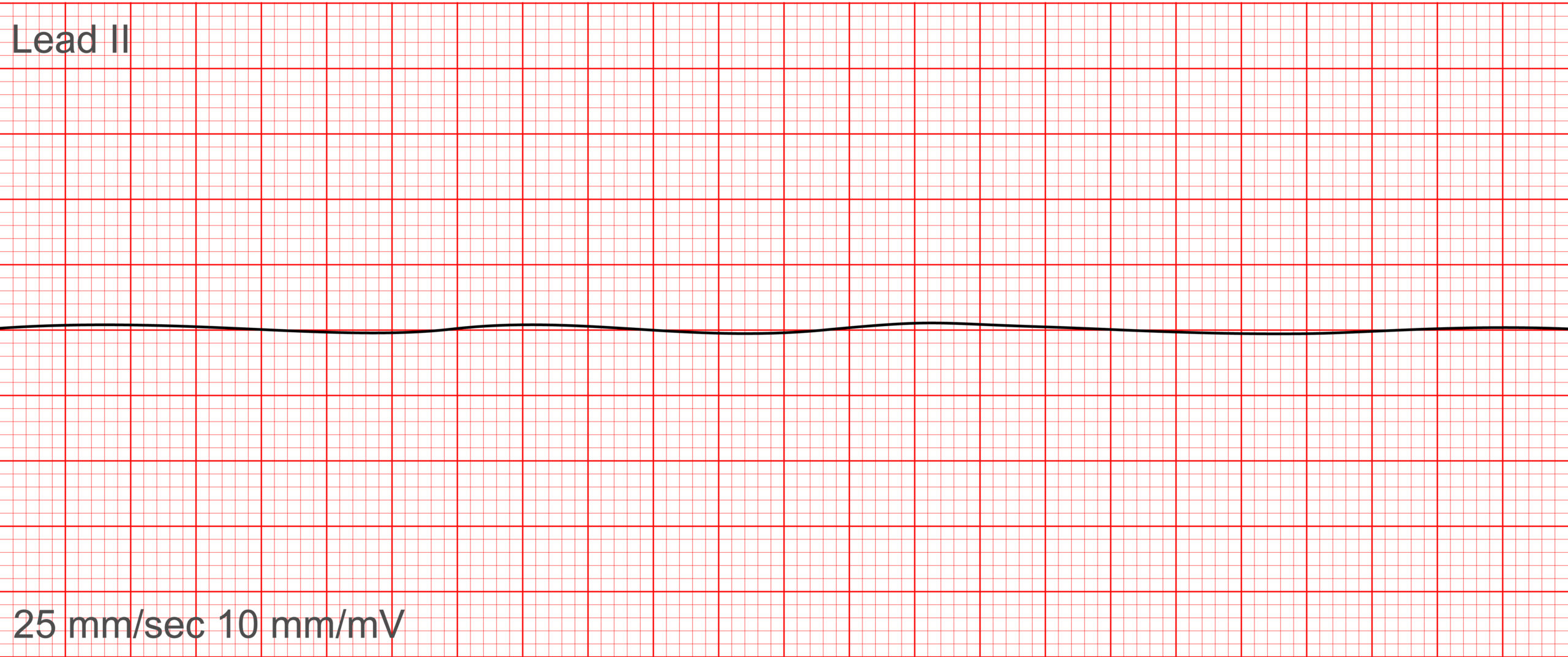Asystole
Asystole signifies a complete lack of ventricle contraction. This is known as the flatline on ECG, although occasional deflections to the electrical pattern can appear. It is important to note that “VF isoelectric vector masquerading as asystole,” “slow PEA,” “fine VF,” or “coarse asystole” are all quite similar to asystole, and there is little clinical benefit of trying to differentiate these.
Related Video: ECG Rhythm Review – Asystole
Related Video: Hs and Ts – Treating Asystole

Cardiac Asystole ECG
Managing Asystole: Airway and Access
Generally, ensuring good IV or IO access comes before advanced airway placement unless the bag-mask does not provide adequate ventilation, or the patient has known hypoxia. All responders should evaluate continuously for the underlying etiology of cardiac arrest while supporting the resuscitation effort.
Natural History of Asystole
Typically, in patients who develop asystole, there is a preceding and progressive bradycardia that occurs over several minutes. This phenomenon is termed a bradyasystolic arrest. Patients will most commonly transition through several rhythms, including bradycardia, heart block, PEA, and finally, asystole. It is rare for patients to transition from a perfusing rhythm directly to asystole. Case reports that document sudden descent into asystole generally discover an inciting and severe vasovagal trigger.
Key Takeaway
The basis for PEA and asystole care are:
- High-quality CPR, specifically chest compressions
- Quick diagnosis and treatment of underlying reversible etiologies
- Prompt administration of epinephrine
Which patients survive asystole?
As discussed above, asystole generally portends a poor prognosis. This is even more true in patients whose first detected rhythm is asystole.
In patients with initial asystole outside of the hospital, studies indicate a dismal 1% survival rate. This rate may be erroneous due to device or user error (such as a disconnected monitor or electrodes). Additionally, certain factors, such as noncardiac etiology, younger age, witnessed arrest, and a minimal delay between arrest and CPR, improve survival rates.
Confirming Asystole
Asystole is a specific ECG rhythm; it is not simply a flat line. Flat lines can refer to multiple scenarios, including mechanical or user error.
These include:
- Loss of power to the defibrillator or monitor
- Artificially low gain
- Disconnection/poor connection of lead connector, cables, or monitor.
- Loss of power
The defibrillator has two power sources, the outlet and a battery. While a total lack of power will cause the monitor to go black, the batteries can slowly lose charge, but the monitor will still display. Still, there is not enough power to support the rapidly charging and discharging defibrillator. This usually occurs if the defibrillator has been inadvertently left unplugged for some time.
Asystole Mimicry
It is theoretically possible that VF can masquerade as asystole. This is thought to occur because the monitor can misinterpret VF as a flat line if it has a sustained vector or direction through the cardiac cells. The theory suggests that asystole can be shocked as this mimicry will respond as VF. However, there has been no evidence that any type of asystole benefits from shock. In fact, patients with asystole who receive shocks tend to do worse than those who do not. Therefore, asystole should not be shocked. (Class III, Evidence level B)
Asystole Pacing
Pacing is generally not of benefit in cardiac arrest and does not increase ROSC or survival. This holds true for transcutaneous, transvenous, and transcardiac methods. Randomized studies reveal that early pacing did not lead to ROSC in patients with primary asystole or asystole following defibrillation. Consequently, the basis of care remains early and effective CPR rather than pacing.